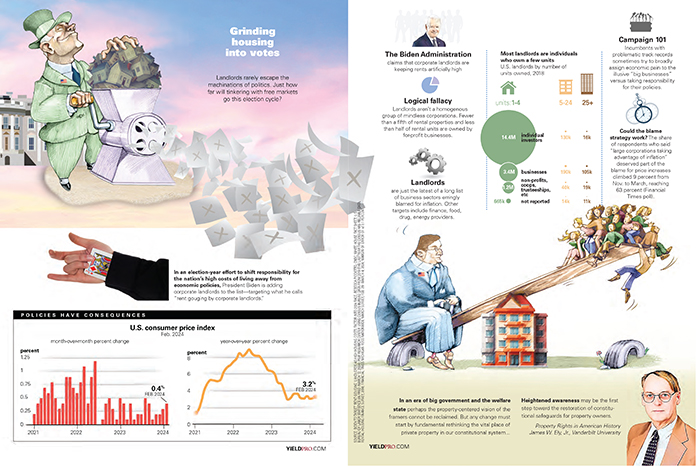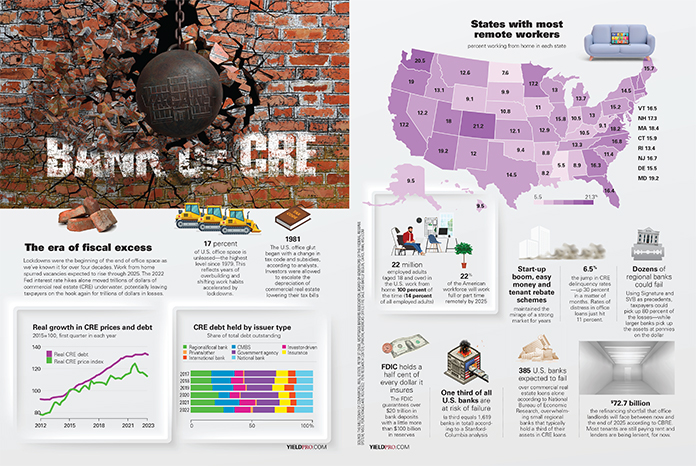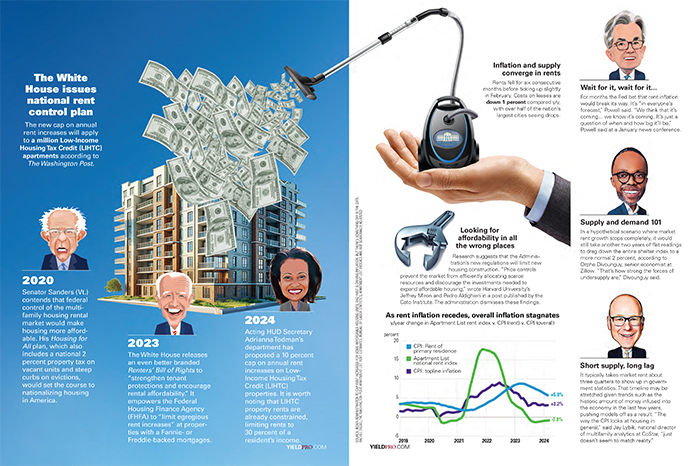In a sense, I approach our marketing and advertising strategy the same way. I am constantly watching how market conditions are affecting my “catch” (the potential resident) and current conditions look increasingly murky.
Around the country, multifamily vacancy rates are creeping up in a majority of urban markets, and competition for qualified renters has become a major issue in 2008. By year-end, it is estimated that eighteen of the top 31 markets around the country will not be at a “supply-demand balance.” Consequently, vacancy rates will be uncomfortably high in many metropolitan areas, with Austin, Charlotte, Houston and Tampa Bay leading the way.
This grim picture should encourage multifamily companies to look for new ways of attracting and signing residents, but this is not always the case. Unfortunately, the multifamily industry has been notoriously slow to adopt new marketing techniques, including the use of technologies that are already old hat in other industries. In today’s difficult economic environment, companies need to focus on converting as many new prospects to leases as possible. This requires prompt response and efficient follow-up at every point in the sales cycle.
Despite the industry’s mediocre lead-to-traffic conversion rates (an average of 5 to 15 percent), the use of one of the most basic marketing tools — the call center — has still not taken firm root within the multifamily sector. Yet, there is ample evidence of the benefits of employing call centers as an integral part of the sales cycle. Nothing is more demoralizing to a sales staff than losing a solid prospect because of the inability to respond rapidly and provide timely follow-up to potential customers. Utilizing call centers can be an effective, uncomplicated way of increasing conversion rates even in a tough economy.
Call centers: time and battle tested
In many industries, call centers have long been a cost-efficient and effective way to off load a variety of corporate functions. In the U.S. there are up to 100,000 call centers, with over three million employees. Add in the internal call centers operated by many large corporations and the numbers increase several times over.
Today’s call centers offer a variety of services, ranging in sophistication and complexity. Apart from basic customer service and order collection, call centers can handle all aspects of e-commerce as well as undertake research and data gathering for business intelligence, performance management and marketing strategies.
For many businesses, call centers are at the core of the relationship between customers and companies. For them, the call center employee is the only person with whom a customer will ever interact. The call center, thus, finds itself serving as “brand ambassador”, a key element of a specific business transaction, a sounding board, and a problem-solver — a one-stop shop for the full range of customer needs. Not only do call center employees help to generate new clients, but they are expected to keep existing customers satisfied.
Call centers have been time and battle tested by American businesses for almost thirty years. It is not difficult to envision the many ways that call centers can assist the multifamily industry today.
Still, 85 to 90 percent of the nation’s 25,000 rental communities have yet to incorporate some type of call center into their operation.
The industry problem: effectively managing leads
The Internet has transformed not only the way in which leads are generated, but also their sheer number and the expectation of potential residents. In the case of AvalonBay, the growth in Internet- generated prospects over the last four years has been remarkable. In 2003, only 24 percent of the company’s leases were sourced through the Internet, compared to over 53 percent today.
Internet leads also occur on a 24/7 basis (they are not dependent on the hours of the on-site leasing office). For example, the total number of email leads sent to our Avalon communities has risen from less than 10,000 in 2003 to over 48,000 in 2007. In many respects, the volume of leads can (and, in the case of AvalonBay, did) overwhelm the leasing offices’ ability to respond promptly and completely.
With the Internet has come a radical adjustment in the prospect’s expectations about response time, and this has had a profound effect on apartment leasing. Prospects who use the Internet expect that their email inquiries will be answered within a relatively short period of time. After all, think about the average office today. If business emails are not answered within 12 to 24 hours (at most), senders become annoyed and wonder about the recipient’s efficiency and organization.
Handling the increasing number of inquiries via email within an acceptable period of time has become increasingly challenging for multifamily companies. It is estimated that the apartment industry is, on average, responding to only about 40 percent of all email leads, letting 60 percent tumble into a black hole. Furthermore, the 40 percent that do receive a response have to wait at least one day and as many as four or five days for that return email. Frustration abounds on both ends of that equation. On one hand, companies can only watch while most of their Internet leads disappear; on the other, the prospect either receives nothing back at all or an email that arrives on average three days later — so much for timeliness in a cyber-speed world. It’s a lose-lose proposition all round.
Cyberspace, however, isn’t the only medium that is experiencing a lack of timely and effective responses to leads. Most companies in the multifamily industry have surprisingly just as much difficulty dealing with telephone inquiries. Local leasing offices, even with extended hours, can’t answer the telephone on a 24/7 basis, an obvious limitation. Further, on-site company leasing teams convert only a dismal average of 10 to 15 percent of all calls into appointments. Confronted with these difficulties, it is only logical that the multifamily industry begin to look seriously at viable and proven outsourcing alternatives.
The call center solution
Like many multifamily companies, AvalonBay recognized the challenges posed by the increasing role of cyberspace in the industry. The company was struggling to keep up with its rapidly increasing lead generation. In 2000, it was “on par” with the competition in responding to only about 40 percent of its email leads. By 2005, its response rate was up to approximately 75 percent, with an average of eight hours to answer those emails. Traditional telephone traffic had high response rates (that is, the telephones were being answered), but a very low 8 to 15 percent conversion rate from call to actual site visit. And both forms of leads were essentially handled at the company within a normal 9 to 5 workday.
With lead generation increasing and traffic-to-lease conversion rates remaining fairly constant (for AvalonBay, around 30 to 35 percent), it was not difficult to see that the marketing opportunity was to convert a higher percentage of leads into site visits. But increasing that conversion rate is a challenge for a company that relies solely on internal resources. It is not viable to simply ask employees to work harder and longer. So, AvalonBay launched an eight-month regional pilot program to test the efficacy of a call center solution.
One of the most important elements of successfully utilizing a call center is to ensure that the outsourced employees are genuine brand ambassadors for the company. If a call center is to play a critical role in the prospect path, then it must be able to represent the company in the fullness of its brand attributes. In the case of AvalonBay, call center employees were trained by AvalonBay marketing professionals and, even today, this training is a regular and high priority. Call center employees can speak with authority about the Avalon brand experience. They are well versed in the details, amenities and benefits of the individual communities.
Right away, call center employees were able to engage prospective residents in longer and more productive conversations about the properties, and they responded to 98 percent of all calls immediately. On average, the call center pilot program held prospects in conversation for 4.7 minutes, compared to 2.5 minutes for the company staff which was often understandably distracted by other on- site duties. The more lengthy conversations, in part, contributed to a significantly higher conversation rate (call-to-appointment): 25 to 40 percent for the call center compared to 10 to 15 percent for AvalonBay. And these were generally highly-qualified leads, since the call center employees were not paid on commission for converted leads.
The call center pilot also dramatically improved the company’s email response rate. Instead of responding to 75 percent of all emails within eight hours, the call center answered 100 percent within two hours. This remarkable achievement was, in part, due to the fact that the call center operated on a 24/7 basis. Thus, emails sent even in the middle of the night were promptly answered and an electronic “guest card” was generated and pushed into the specific Avalon community’s property management system. The guest card included all the necessary prospect information so that the on-site leasing associate could quickly follow-up, confirming the appointment and answering any questions. Another interesting data point gained from the pilot was that 21 percent of all leases came from guest cards that were generated outside the standard office hours.
Once the pilot was rolled out nationally, the after-hours capability of the call center captured, in the first six months, over 21,000 additional telephone and email leads, which ultimately converted into nearly 1,200 leases. It is not unreasonable to assume that the vast majority, if not all, of these leases would not have been captured at all without an after-hours capability. The ability to respond to 100 percent of all incoming emails and the call center’s higher conversion rate (emails-to-appointments) resulted in a three-fold increase in leases derived from email traffic. Clearly, the use of the call center more than paid for itself. Beyond the cost- efficiencies, however, the call center generated a wide range of reports, based on reams of data, which helped AvalonBay to fine tune its marketing and advertising strategies.
Although the benefits of call centers can be empirically demonstrated, companies do need to assess the potential downside. For example, there is a substantial upfront investment cost, although it should eventually be recovered by reduced spends for alternative media and by increased numbers of leases. In addition, call centers employees need to be carefully managed by the company using them, so that they can be effective representatives of the brand. Finally, because they are not local to the neighborhoods, they sometimes cannot respond to granular questions about the localities. Still, in the end, the benefits outweigh the costs by any fair evaluation.
Conclusion
Ours is an industry that changes slowly and adopts new technology at a glacier-like pace. Many of the marketing techniques that still dominate the multifamily industry have largely remained the same for the last 50 years: banners, A-frames, traditional print advertisements and guides. Cyber-marketing has taken a relatively long time to impact and penetrate the industry, but it has arrived, and with it has come an increasing, Internet-driven flow of potential customers with expectations that have been set by sectors, like banking and financial services, that are far more cyber-savvy than real estate.
A call center is not a magic bullet that will disperse the specter of cyber-marketing ogres circling around the genteel multifamily industry. However, call centers do respond to, and surmount, some of the most difficult challenges presented by our increasingly Internet- oriented customer base. Failing to appreciate that many of the best prospects for multifamily dwellings today prefer to operate primarily through email and the Internet is a recipe for disaster. It’s time our industry stepped, four square, into the 21st century. .
Author: Kevin Thompson is vice president of AvalonBay, one of the nation’s top Real Estate Investment Trusts.















